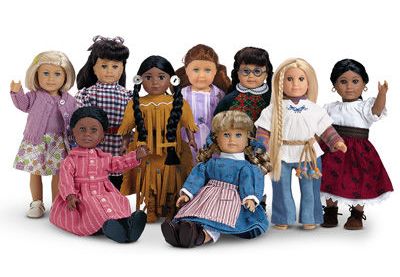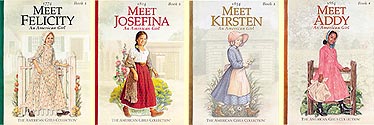The “American Girl” Franchise
When I was little, one of my favorite book series was the American Girl series. This collection of chapter books followed the lives of several young girls from different time periods and classes in American history – all hinging upon the common denominator of their titular national identity and exploring the story directly through the girls’ viewpoints. These books were created chiefly to advertise to children (more specifically girls) the line of character dolls upon which the American Girl company was originally built, in the same vein of such toy lines as Transformers and My Little Pony. Selling for upwards of a hundred dollars (and initially only available by mail-order) when you factor in toy accessories and doll dress-up, the American Girl dolls were expensive enough to require additional persuasion in the form of books, movies, and even games. After all, parental resistance in the face of cost to satisfying a child’s preference for a particular character or story tends to wane the more enamored the child becomes with the pageantry of a full product line.
The original line of 18-inch dolls was first released in 1986 by Pleasant Company, which has since become a subsidiary of Mattel, the giant behind “Barbie”. A magazine devoted entirely to American Girl products came out in response to the line’s success, as well as dedicated American Girl Place stores in large cities across the U.S. American Girl Magazine in particular includes articles, advice columns, arts and crafts, and activity ideas targeting girls aged 8-14 in echo of earlier publications whose major innovation was advertising directly to children, perhaps providing a preliminary to the content of “feminine” magazines such as Seventeen magazine and Cosmopolitan sold to teen girls and young women. American Girl also prominently features look-alike outfits for dolls and doll owners. It is clear that the young readers and consumers of American Girl products are meant to identify with the characters the company represents through these various vehicles.
The American Girl books I enjoyed as a child are topically gendered, although the company has shown, through its diverse range of protagonists, an effort to be inclusive of all types of female perspective as well as progressive posturing on issues peripheral to feminism. However, as reflected in our readings, gender-specification of toys had not been viewed as negative and had in fact served as moral instruction until most recent decades. While the doll as a gendered toy seems a far-gone conclusion, each American Girl book seemed to reflect more updated views on gender than any fairly innocuous but historically loaded line of dolls might normally suggest. Every installment featured the central character getting into the kind of outdoor and out of the norm adventures and trouble reserved for boys’ books in earlier periods up to and overflowing from the mid 20th century. Overall, the protagonists provided modern girls with positive role models which, while perhaps glossing over their historical themes of child labor, abuse, poverty, racism, sexism and etc., nevertheless provided an introduction to such issues in a format where the every-girl heroine central to the plot always seems to triumph in a nontraditional manner outside of the domestic sphere which obsessed 19th century girls’ literature.
The invention of the line brings to our attention an interesting dichotomy of gender exclusivity (which obviously carries negative connotations) and “girl power” in contemporary children’s entertainment. Beyond my own sense of nostalgia surrounding the franchise, I am compelled to ask when looking at toys such as the American Girl dolls today: how has the welcome evolution of feminism impacted the gendering of toys today if it has apparently not neutralized it? To what extent is the gendering of entertainment in childhood responsive to a phase (“girls rule/boys drool”) or something which carries helpful messages of self-esteem into adulthood?



I only have a ten month old dhtuager so I’m really not up on all the American Dolls. It seems even more involved that the Cabbage Patch Kids craze way back.